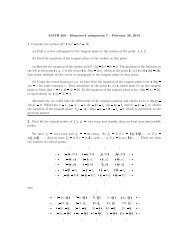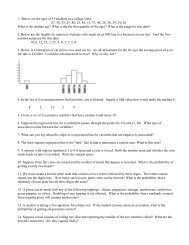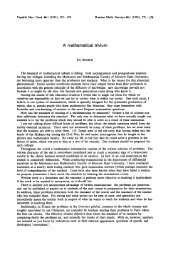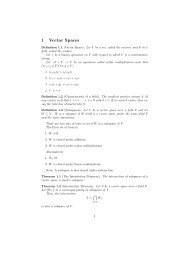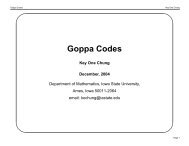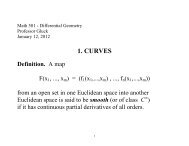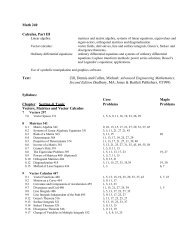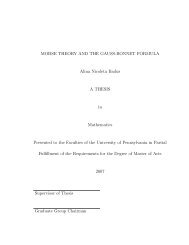Barcodes - Department of Mathematics
Barcodes - Department of Mathematics
Barcodes - Department of Mathematics
Create successful ePaper yourself
Turn your PDF publications into a flip-book with our unique Google optimized e-Paper software.
10 ROBERT GHRIST<br />
A codensity function is used in [3] as follows. Fix a positive integer k > 0.<br />
For any point xα in the data set, define δk(xα) as the distance in E n from xα to<br />
k th nearest neighbor <strong>of</strong> xα in the data set. For a fixed value <strong>of</strong> k, δk is a positive<br />
distribution over the point cloud which measures the radius <strong>of</strong> the ball needed to<br />
enclose k neighbors. Values <strong>of</strong> δk are thus inversely related to the point cloud<br />
density. The larger a value <strong>of</strong> k used, the more averaging occurs among neighbors,<br />
blurring finer variations.<br />
The codensity is used to filter the data as follows. Denote by M[k, T] the subset<br />
<strong>of</strong> M in the upper T-percent <strong>of</strong> density as measured by δk. This is a two-parameter<br />
subset <strong>of</strong> the point cloud which, for reasonable values <strong>of</strong> k and T, represent an<br />
appropriate core.<br />
3.3. “When shall we three meet again?” The first interesting persistent homology<br />
computation on this data set occurs at the level <strong>of</strong> H1: to what extent are<br />
there ‘loops’ in the data set along which the cloud is concentrated?<br />
Taking a density threshold <strong>of</strong> T = 25 at neighbor parameter k = 300, with<br />
5000 points sampled at random from M[k, T], computing the barcode for the first<br />
homology H1 reveals a unique persistent generator [3]. See Figure 5. This indicates<br />
that the data set is diffused about a primary circle in the 7-sphere. The structure <strong>of</strong><br />
the barcode is robust with respect to the random sampling <strong>of</strong> the points in M[k, T].<br />
The goal <strong>of</strong> the homology computation is to discover a ‘hidden’ feature <strong>of</strong> a data<br />
set that is not discernable by clustering and connectivity alone. The simplest such<br />
feature would be, as indicated by the computation above, a primary circle about<br />
which the data is scattered. To what might this correspond? A close examination<br />
<strong>of</strong> the data point corresponding to the primary circle reveals a pattern <strong>of</strong> 3-by-3<br />
patches with one light region and one dark region separated by a linear transition.<br />
This nodal curve between light and dark is linear and appears in a circular family<br />
parameterized by the angle <strong>of</strong> the nodal line, as shown in Figure 5.<br />
As seen from the barcode, this generator is dominant at the threshold and codensity<br />
parameters chosen. An examination <strong>of</strong> the barcodes for the first homology<br />
group H1 <strong>of</strong> the data set filtered by codensity parameter k = 15 and threshold<br />
T = 25 reveals a different persistent first homology. The reduction in k leads to<br />
less averaging and more localized density sensitivity. The barcode <strong>of</strong> Figure 6 reveals<br />
that the persistent H1 <strong>of</strong> samples from M[k, T] has Betti number five. This<br />
does not connote the presence <strong>of</strong> five disjoint circles in the data set. Rather, by<br />
focusing on the generators and computing the barcode for H0, it is observed [3]<br />
that, besides the primary circle from the high-k H1 computation, there are two<br />
secondary circles which come into view at the lower density parameter.<br />
A close examination <strong>of</strong> these three circles reveals that each intersects the highk<br />
primary twice, yet the two secondary circles are disjoint. To what features in<br />
the data might these secondary circles correspond? As noted in [3], each secondary<br />
circle regulates images with three contrasting regions and interpolates between these<br />
states and the primary circle. The difference between the two secondary circles lies<br />
in their bias for horizontal and vertical stratification respectively. Figure 7 gives an<br />
interpretation <strong>of</strong> the meanings <strong>of</strong> the secondary circles.<br />
3.4. “Come like shadows, so depart!” What is the good <strong>of</strong> temporary topological<br />
features which emerge and dissolve as a function <strong>of</strong> the parameter ǫ? Does<br />
this lead to anything more than a heuristic for high-dimensional data sets that are



